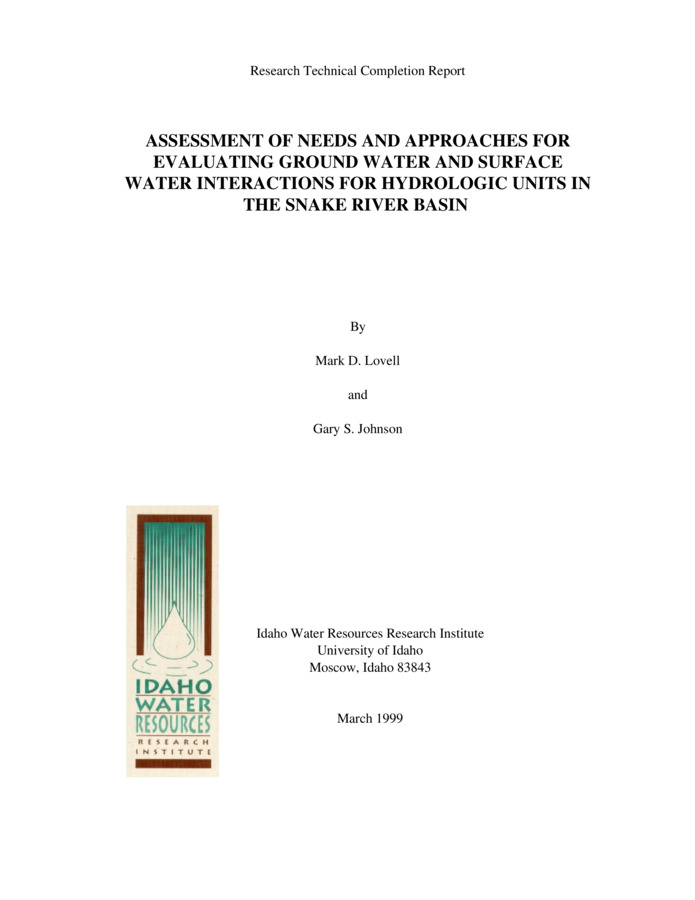PDF
Assessment of needs and approaches for evaluating groundwater and surface water interactions for hydrologic units in the Snake River Basin Item Info
- Title:
- Assessment of needs and approaches for evaluating groundwater and surface water interactions for hydrologic units in the Snake River Basin
- Authors:
- Lovell, Mark D.; Johnson, Gary S.
- Date Created (ISO Standard):
- 1999-03
- Description:
- The Snake River Basin, located in Idaho, Wyoming, Oregon, Nevada, and Utah, is experiencing increasing demands on a finite amount of water. The complexity of water allocation is magnified by the size of the basin and the varied types of interests competing for water. Irrigation interests, municipalities, flood control operators, tribal needs, industrial uses, domestic supply, recreation and species habitat requirements are all exerting demands on the water system. To enhance decision making abilities as related to water allocation, the United States Bureau of Reclamation initiated the Snake River Resources Review (SR3). The SR3 project involves all Snake River drainage areas upstream from Brownlee Dam, located on the Idaho Oregon border. In support of the SR3 study, this report addresses the groundwater surface water interactions between the tributary basins and Snake River. The entire study area was subdivided into geographic areas utilizing the hydrologic unit boundaries (HUCs) established by the U. S. Geological Survey (USGS). Data were accumulated to identify areas where groundwater use may be sufficient to materially impact surface water flow. The data sets include: (1) groundwater-rights (location, amount, priority date), (2) water table fluctuations, (3) agricultural land use, and (4) recorded stream flow measurements. Current rules for conjunctive management of the surface water and groundwater systems were also reviewed. Aquifers in much of the Snake River basin in Idaho have been modeled by previous efforts. In this study, individual HUCs were compared to one another utilizing the criteria suggested by the Idaho Department of Water Resources (IDWR) for prioritizing areas where additional or more detailed groundwater modeling should be performed. From this basin wide approach, 6 areas received a High Priority ranking: Teton, Raft, Big Lost, Big Wood, Portneuf, and Salmon Falls. Areas receiving a Medium Priority include Middle-Snake Succor, Bruneau, C. J. Strike Reservoir, Camas, and Blackfoot. Water table fluctuations observed in wells, measured by the USGS, indicate that not all wells in a given region show an equal response to stresses on the water system. Basin-wide changes in the water table seem to correlate with climatic periods of drought or non-drought.
- Subjects:
- Aquifers Computer models Computer simulation Well hydrographs
- Location:
- Snake River Basin; Southern Idaho
- Latitude:
- 42.96
- Longitude:
- -115.13
- Collection:
- Boise Basin
- Rights:
- In copyright, educational use permitted. Educational use includes non-commercial reproduction of text and images in materials for teaching and research purposes. For other contexts beyond fair use, including digital reproduction, please contact the University of Idaho Library Special Collections and Archives Department at libspec@uidaho.edu. The University of Idaho Library is not liable for any violations of the law by users.
- Publisher:
- Idaho Water Resources Research Institute; University of Idaho
- Contributing Institution:
- University of Idaho
- Type:
- Text
- Format:
- application/pdf
- Cataloger:
- KIT
Source
- Preferred Citation:
- "Assessment of needs and approaches for evaluating groundwater and surface water interactions for hydrologic units in the Snake River Basin", Idaho Waters Digital Library, University of Idaho Library Digital Collections, https://www.lib.uidaho.edu/digital/iwdl/items/iwdl-1999-03.html
Rights
- Rights:
- In copyright, educational use permitted. Educational use includes non-commercial reproduction of text and images in materials for teaching and research purposes. For other contexts beyond fair use, including digital reproduction, please contact the University of Idaho Library Special Collections and Archives Department at libspec@uidaho.edu. The University of Idaho Library is not liable for any violations of the law by users.
- Standardized Rights:
- http://rightsstatements.org/vocab/InC-EDU/1.0/

